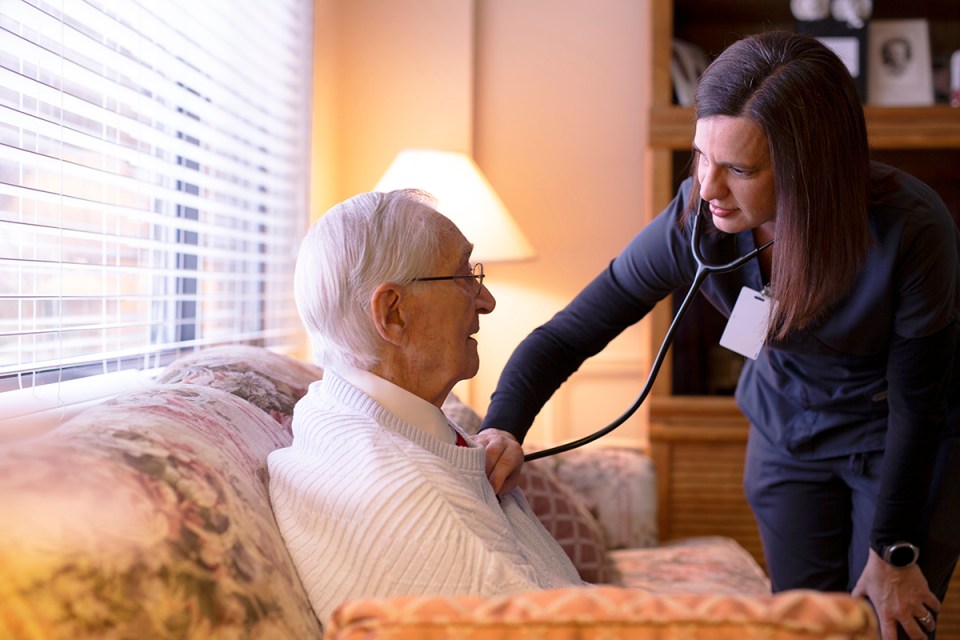Chronic obstructive pulmonary disease, commonly referred to as COPD, is a long-term lung disease that makes it hard for you to breathe.
According to the Centers for Disease Control and Prevention, COPD impacts over 16 million Americans and many more don’t even know they’re living with this disease.
What are the types of COPD?
There are two main types of COPD: chronic bronchitis and emphysema.
Chronic bronchitis
Chronic bronchitis causes swelling and scarring to the lining of the bronchial tubes, which are responsible for carrying oxygen to your air sacs. This makes it harder for air to flow back and forth to the lungs and causes you to cough up thick, heavy mucus.
Chronic bronchitis is determined by if your cough lasts most days of the month, three months out of the year for two years in a row, without another reason to explain the cough.
Emphysema
Emphysema affects the air sacs, which is where oxygen and carbon dioxide trade places. Emphysema creates holes in the thin, fragile walls of the air sacs and makes it harder for the lungs to keep your airways open. This makes it difficult to exhale and therefore get rid of carbon dioxide.
What causes COPD?
Smoking is currently the leading cause of COPD. If you have a history of smoking or currently smoke tobacco products, you have a higher risk of developing COPD. Second-hand exposure to tobacco smoke also plays a role in the development of COPD.
Years of exposure to air pollutants, such as chemicals, fumes or dust, can also increase your risk of developing COPD. There may be a genetic component as well as a family history of COPD can also increase your risk.
What are the symptoms of COPD?
COPD symptoms come on gradually and worsen over time, so it’s common for many people to not recognize the early stages of the disease. Symptoms begin once your body cannot get enough oxygen or struggles to get rid of carbon dioxide.
Early stage symptoms include:
- A cough that lasts a long time or produces a lot of mucus
- Shortness of breath or you become “winded” easily, especially with physical activity
- A tight feeling in your chest
- A wheezing “rattle” or “whistle” in your chest when you breathe
As COPD progresses over time, your lungs start to show more signs of damage. This means that your body isn’t getting the oxygen it needs.
Advanced symptoms include:
- Muscle weakness
- Weight loss
- Difficulty catching your breath during any activity
- Lips and nail beds turn grey or blue in color
- Swelling in your legs, feet or ankles
- Fast heartbeat
- Frequent colds or flu
What can you do to manage COPD?
Your lungs are affected by many factors, including what you eat, your level of activity, where you live and the medications you take. Although COPD isn’t curable, there are things you can do to increase your quality of life and better manage your condition.
Stop smoking and avoid harmful irritants
If you currently smoke, quitting is the first step in better managing your COPD. Make sure to avoid other harmful irritants as well, such as dust, pollens, chemical fumes, car exhaust, or other strong smells like perfume.
Eat a well-balanced diet
Many people are surprised to learn that the food they eat can affect their breathing. Getting the right mix of nutrients can help you better manage your COPD. Try eating slowly, stopping often between bites. It can also help to avoid gas-forming foods as these cause your stomach to bloat and can make it harder to breathe.
Manage your medications
Take your medications exactly as prescribed and keep an accurate list of all the prescription and over-the-counter medications you take as they impact how well your lungs perform. Be sure to talk to your physician before taking any new medications, vitamins or herbs as some of them can make your COPD worse.
Exercise regularly
Regular activity and exercise help your lungs by improving their ability to take in oxygen. Make sure exercise is controlled and approved by your physician, as uncontrolled exercise can put extra strain on your lungs.
Track your symptoms
Identifying changes is an important part of managing your COPD. Use a journal to make note of symptoms like your ability to exercise, weight, pulse and any swelling you notice. Notify your physician if you notice significant changes.
The content of this site is for informational purposes only and should not be taken as professional medical advice. Always seek the advice of your physician or other qualified healthcare provider with any questions you may have regarding any medical conditions or treatments.



